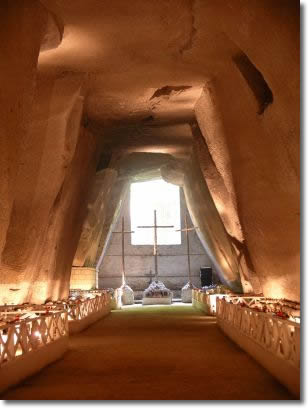Warning! The template for this page [TurismoCultura.html] doesn't exists.
Rites and mysteries
The information in this section illustrates the fascinating underground world of Naples, including the catacombs and places of worship like the Church of San Pietro ad Aram and the Church of the Anime del Purgatorio, the incredible Fontanelle Cemetery and the mysterious Cemetery of the 366 graves.
Underground Naples
Not many people know the stories and the mystery surrounding the underground city of Naples. The underground city originated at the same time as the one above ground and developed alongside it. Naples grew up by the sea but it was also influenced by the volcano Vesuvius. The tuff, pozzolane, and rocks that the city stands on were the result of previous eruptions, and Naples always used the stone it found on its hillsides and valleys to help it grow in stature.

- The Fontanelle cemetry
The Catacombs
The many underground cemeteries in Naples are mainly found on the slopes of the Aminei hills and the Sanità-Vergini area, traditionally known as the "valley of death". These sites were chosen because of the quality of the tuff which enabled them to dig out large tunnels to extract building materials or make underground reservoirs to store water. The ancient catacombs lying under the city of Naples include those of Saint Gaudioso, but obviously the most famous and imposing are the Saint Gennaro Catacombs, which boast some wonderful frescoes and mosaics as well...
The Basilica of San Pietro ad Aram
Tradition has it that the Basilica of San Pietro ad Aram was built on the site where St. Peter celebrated mass for the first time and baptised Saint Candida and Saint Aspreno, the first Neapolitans to convert to Christianity. The word "Aram" comes from "Ara Petri", the stone Peter used as an altar to celebrate mass. Various bishops like Saint Silvestro I, Saint Pelagio, Saint Gregorio Magno and Saint Nestoriano, an African bishop who landed in Naples with Saint Gaudioso, also celebrated mass on this same stone altar...
The church of Santa Maria delle Anime del Purgatorio ad Arco
Right in the middle of the Decumanus Maggiore, the unmistakeable, majestic form of the Church of Santa Maria delle Anime del Purgatorio ad Arco rises above the chaos of everyday life. The church was built in 1616 by a group of noblemen who decided to found the Congrega di Purgatorio ad Arco, a humanitarian organisation to help the poor, the sick and women in trouble. Cosimo Fanzago was the official builder, but, in reality, the end product is the result of the work of a group of famous sculptors...
The Fontanelle cemetry
The Fontanelle cemetery is an old tuff quarry in the Sanità area of Naples, which dates back to the Aragonese period. The quarry provided building materials for local housing. The name "Fontanelle", or small fountains, comes from the numerous underground springs in the area. During XVII century, the quarry was used as a cemetery to bury the victims of the plague, especially the 1656 outbreak which was so serious that the resultant poverty and epidemics affected the city for the whole of XVIII century and well into XIX as well...
The cemetery with 366 graves
It was in 1762, three years after Charles of Bourbon had left for Spain, that the Minister Bernardo Tanucci commissioned the Florentine architect Ferdinando Fuga to design a cemetery for the people on the Poggioreale hill. During the Bourbon period in Naples in XVIII century, the ghettoisation of the masses, or the problems relating to the lives and deaths of the less well-to-do, was solved by creating specific facilities for them: the Royal Hotel for the Poor, which was also built by Ferdinando Fuga in 1751 to help all the homeless people who drifted around the city, and the Cemetery with 366 graves, which was extremely important because, before this was built, the bodies of poorer people were often just thrown into the pit at the Hospital for Incurable Diseases or buried in outlying districts of the city...
Accetto la cookie policyContinuando ad utilizzare questo sito l'utente acconsente all'utilizzo dei cookie sul browser come descritto nella nostra cookie policy, a meno che non siano stati disattivati. È possibile modificare le impostazioni dei cookie nelle impostazioni del browser, ma parti del sito potrebbero non funzionare correttamente. visualizza la cookie policy
Accept

 read all
read all